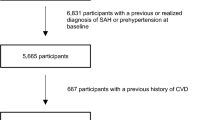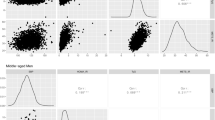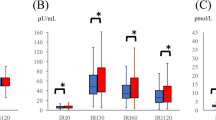Abstract
Here we examined whether the Matsuda–DeFronzo insulin sensitivity index (ISI-M) is more efficient than the homeostasis model assessment of insulin resistance (HOMA-IR) for assessing risk of hypertension. Cross-sectional and longitudinal analyses were conducted using normotensive subjects who were selected among 1399 subjects in the Tanno–Sobetsu cohort. In the cross-sectional analysis (n=740), blood pressure (BP) level was correlated with HOMA-IR and with ISI-M, but correlation coefficients indicate a tighter correlation with ISI-M. Multiple linear regression analysis adjusted by age, sex, body mass index (BMI) and serum triglyceride level (TG) showed contribution of ISI-M and fasting plasma glucose, but not of HOMA-IR. In the longitudinal analysis (n=607), 241 subjects (39.7%) developed hypertension during a 10-year follow-up period, and multiple logistic regression indicated that age, TG, systolic BP and ISI-M, but not HOMA-IR, were associated with development of hypertension. In subjects <60 years old, odds ratio of new-onset hypertension was higher in the low ISI-M group (ISI-M, less than the median) than in the high ISI-M group for any tertile of BMI. In conclusion, ISI-M is a better predictor of hypertension than is HOMA-IR. Non-hepatic IR may be a determinant, which is independent of TG, BP level and BMI, of the development of hypertension.
This is a preview of subscription content, access via your institution
Access options
Subscribe to this journal
Receive 12 digital issues and online access to articles
$119.00 per year
only $9.92 per issue
Buy this article
- Purchase on Springer Link
- Instant access to full article PDF
Prices may be subject to local taxes which are calculated during checkout



Similar content being viewed by others
References
O’Seaghdha CM, Perkovic V, Lam TH, McGinn S, Barzi F, Gu DF et al. Blood pressure is a major risk factor for renal death: an analysis of 560 352 participants from the Asia-Pacific region. Hypertension 2009; 54: 509–515.
Zheng Y, Stein R, Kwan T, Yu C, Kwan J, Chen SL et al. Evolving cardiovascular disease prevalence, mortality, risk factors, and the metabolic syndrome in China. Clin Cardiol 2009; 32: 491–497.
Agyemang C, Addo J, Bhopal R, de Graft Aikins A, Stronks K . Cardiovascular disease, diabetes and established risk factors among populations of sub-Saharan African descent in Europe: a literature review. Global Health 2009; 5: 7.
Lavie CJ, Milani RV, Ventura HO . Obesity and cardiovascular disease: risk factor, paradox, and impact of weight loss. J Am Coll Cardiol 2009; 53: 1925–1932.
Redon J, Cifkova R, Laurent S, Nilsson P, Narkiewicz K, Erdine S et al. Mechanisms of hypertension in the cardiometabolic syndrome. J Hypertens 2009; 27: 441–451.
Savage DB, Petersen KF, Shulman GI . Mechanisms of insulin resistance in humans and possible links with inflammation. Hypertension 2005; 45: 828–833.
Chapman MJ, Sposito AC . Hypertension and dyslipidaemia in obesity and insulin resistance: pathophysiology, impact on atherosclerotic disease and pharmacotherapy. Pharmacol Ther 2008; 117: 354–373.
Razani B, Chakravarthy MV, Semenkovich CF . Insulin resistance and atherosclerosis. Endocrinol Metab Clin North Am 2008; 37: 603–621, viii.
Tsuchihashi K, Hikita N, Hase M, Agata J, Saitoh S, Nakata T et al. Role of hyperinsulinemia in atherosclerotic coronary arterial disease: studies of semi-quantitative coronary angiography. Intern Med 1999; 38: 691–697.
Wassink AM, van der Graaf Y, Olijhoek JK, Visseren FL . Metabolic syndrome and the risk of new vascular events and all-cause mortality in patients with coronary artery disease, cerebrovascular disease, peripheral arterial disease or abdominal aortic aneurysm. Eur Heart J 2008; 29: 213–223.
Pierdomenico SD, Lapenna D, Di Tommaso R, Di Carlo S, Caldarella MP, Neri M et al. Prognostic relevance of metabolic syndrome in hypertensive patients at low-to-medium risk. Am J Hypertens 2007; 20: 1291–1296.
Takeuchi H, Saitoh S, Takagi S, Ohnishi H, Ohhata J, Isobe T et al. Metabolic syndrome and cardiac disease in Japanese men: applicability of the concept of metabolic syndrome defined by the National Cholesterol Education Program-Adult Treatment Panel III to Japanese men—the Tanno and Sobetsu Study. Hypertens Res 2005; 28: 203–208.
Rooney DP, Edgar JD, Sheridan B, Atkinson AB, Bell PM . The effects of low dose insulin infusions on the renin angiotensin and sympathetic nervous systems in normal man. Eur J Clin Invest 1991; 21: 430–435.
Shimamoto K, Hirata A, Fukuoka M, Higashiura K, Miyazaki Y, Shiiki M et al. Insulin sensitivity and the effects of insulin on renal sodium handling and pressor systems in essential hypertensive patients. Hypertension 1994; 23: I29–I33.
Miyazaki Y, Murakami H, Hirata A, Fukuoka M, Masuda A, Ura N et al. Effects of the angiotensin converting enzyme inhibitor temocapril on insulin sensitivity and its effects on renal sodium handling and the pressor system in essential hypertensive patients. Am J Hypertens 1998; 11: 962–970.
Garrison RJ, Kannel WB, Stokes III J, Castelli WP . Incidence and precursors of hypertension in young adults: the Framingham Offspring Study. Prev Med 1987; 16: 235–251.
Shetterly SM, Rewers M, Hamman RF, Marshall JA . Patterns and predictors of hypertension incidence among Hispanics and non-Hispanic whites: the San Luis Valley Diabetes Study. J Hypertens 1994; 12: 1095–1102.
Ohmori S, Kiyohara Y, Kato I, Ohmura T, Iwamoto H, Nakayama K et al. Hyperinsulinaemia and blood pressure in a general Japanese population: the Hisayama Study. J Hypertens 1994; 12: 1191–1197.
Feskens EJ, Tuomilehto J, Stengard JH, Pekkanen J, Nissinen A, Kromhout D . Hypertension and overweight associated with hyperinsulinaemia and glucose tolerance: a longitudinal study of the Finnish and Dutch cohorts of the Seven Countries Study. Diabetologia 1995; 38: 839–847.
Haffner SM, Miettinen H, Gaskill SP, Stern MP . Metabolic precursors of hypertension. The San Antonio Heart Study. Arch Intern Med 1996; 156: 1994–2001.
Tsuruta M, Hashimoto R, Adachi H, Imaizumi T, Nomura G . Hyperinsulinaemia as a predictor of hypertension: an 11-year follow-up study in Japan. J Hypertens 1996; 14: 483–488.
Imazu M, Yamamoto H, Toyofuku M, Sumii K, Okubo M, Egusa G et al. Hyperinsulinemia for the development of hypertension: data from the Hawaii-Los Angeles-Hiroshima Study. Hypertens Res 2001; 24: 531–536.
Hirose H, Saito I, Kawabe H, Saruta T . Insulin resistance and hypertension: seven-year follow-up study in middle-aged Japanese men (the KEIO study). Hypertens Res 2003; 26: 795–800.
Ferrannini E, Balkau B, Coppack SW, Dekker JM, Mari A, Nolan J et al. Insulin resistance, insulin response, and obesity as indicators of metabolic risk. J Clin Endocrinol Metab 2007; 92: 2885–2892.
Bonora E, Capaldo B, Perin PC, Del Prato S, De Mattia G, Frittitta L et al. Hyperinsulinemia and insulin resistance are independently associated with plasma lipids, uric acid and blood pressure in non-diabetic subjects. The GISIR database. Nutr Metab Cardiovasc Dis 2008; 18: 624–631.
Higashiura K, Ura N, Takada T, Agata J, Yoshida H, Miyazaki Y et al. Alteration of muscle fiber composition linking to insulin resistance and hypertension in fructose-fed rats. Am J Hypertens 1999; 12: 596–602.
Higashiura K, Ura N, Takada T, Li Y, Torii T, Togashi N et al. The effects of an angiotensin-converting enzyme inhibitor and an angiotensin II receptor antagonist on insulin resistance in fructose-fed rats. Am J Hypertens 2000; 13: 290–297.
Rizzoni D, Pasini E, Flati V, Rodella LF, Paiardi S, Assanelli D et al. Angiotensin receptor blockers improve insulin signaling and prevent microvascular rarefaction in the skeletal muscle of spontaneously hypertensive rats. J Hypertens 2008; 26: 1595–1601.
Wei Y, Sowers JR, Clark SE, Li W, Ferrario CM, Stump CS . Angiotensin II-induced skeletal muscle insulin resistance mediated by NF-kappaB activation via NADPH oxidase. Am J Physiol Endocrinol Metab 2008; 294: E345–E351.
Kratochvilova S, Vyhnanovska P, Vlasakova Z, Hajek M, Skibova J, Pelikanova T . Metabolic characteristics of soleus muscle in relation to insulin action in the offspring of hypertensive parents. Metabolism 2006; 55: 1388–1396.
Hernandez N, Torres SH, Vera O, De Sanctis JB, Flores E . Muscle fiber composition and capillarization in relation to metabolic alterations in hypertensive men. J Med 2001; 32: 67–82.
Abdul-Ghani MA, Matsuda M, DeFronzo RA . Strong association between insulin resistance in liver and skeletal muscle in non-diabetic subjects. Diabet Med 2008; 25: 1289–1294.
Matsuda M, DeFronzo RA . Insulin sensitivity indices obtained from oral glucose tolerance testing: comparison with the euglycemic insulin clamp. Diabetes Care 1999; 22: 1462–1470.
Takagi S, Saitoh S, Nakano M, Hayashi Y, Obara F, Onishi H et al. Relationship between blood pressure level and mortality rate: an 18-year study conducted in two rural communities in Japan. J Hypertens 2000; 18: 139–144.
Ohnishi H, Saitoh S, Ura N, Takagi S, Obara F, Akasaka H et al. Relationship between insulin resistance and accumulation of coronary risk factors. Diabetes Obes Metab 2002; 4: 388–393.
Ohnishi H, Saitoh S, Takagi S, Ohata J, Takeuchi H, Isobe T et al. Incidence of insulin resistance in obese subjects in a rural Japanese population: the Tanno and Sobetsu study. Diabetes Obes Metab 2005; 7: 83–87.
Ohnishi H, Saitoh S, Takagi S, Ohata J, Isobe T, Kikuchi Y et al. Relationship between insulin-resistance and remnant-like particle cholesterol. Atherosclerosis 2002; 164: 167–170.
Matthews D HJ, Rudenski A, Naylor B, Treacher D, Turner R . Homeostasis model assessment: insulin resistance and β-cell function from fasting plasma glucose and insulin concentrations in man. Diabetologia 1985; 28: 412–419.
Fukuyama N, Homma K, Wakana N, Kudo K, Suyama A, Ohazama H et al. Validation of the friedewald equation for evaluation of plasma LDL-cholesterol. J Clin Biochem Nutr 2008; 43: 1–5.
Arima H, Tanizaki Y, Yonemoto K, Doi Y, Ninomiya T, Hata J et al. Impact of blood pressure levels on different types of stroke: the Hisayama study. J Hypertens 2009; 27: 2437–2443.
Takashima N, Miura K, Hozawa A, Kadota A, Okamura T, Nakamura Y . Population attributable fraction of smoking and metabolic syndrome on cardiovascular disease mortality in Japan: a 15-year follow up of NIPPON DATA90. BMC Public Health 2010; 10: 306.
Chu MC, Cosper P, Orio F, Carmina E, Lobo RA . Insulin resistance in postmenopausal women with metabolic syndrome and the measurements of adiponectin, leptin, resistin, and ghrelin. Am J Obstet Gynecol 2006; 194: 100–104.
Belfiore F, Iannello S, Volpicelli G . Insulin sensitivity indices calculated from basal and OGTT-induced insulin, glucose, and FFA levels. Mol Genet Metab 1998; 63: 134–141.
Cederholm J, Wibell L . Insulin release and peripheral sensitivity at the oral glucose tolerance test. Diabetes Res Clin Pract 1990; 10: 167–175.
Yeckel CW, Weiss R, Dziura J, Taksali SE, Dufour S, Burgert TS et al. Validation of insulin sensitivity indices from oral glucose tolerance test parameters in obese children and adolescents. J Clin Endocrinol Metab 2004; 89: 1096–1101.
Abdul-Ghani MA, Balas B, Matsuda M, DeFronzo RA . Muscle and liver insulin resistance indexes derived from the oral glucose tolerance test. Diabetes Care 2007; 30: 89–94.
McGill JB, Haffner S, Rees TJ, Sowers JR, Tershakovec AM, Weber M . Progress and controversies: treating obesity and insulin resistance in the context of hypertension. J Clin Hypertens (Greenwich) 2009; 11: 36–41.
Cooper SA, Whaley-Connell A, Habibi J, Wei Y, Lastra G, Manrique C et al. Renin-angiotensin-aldosterone system and oxidative stress in cardiovascular insulin resistance. Am J Physiol Heart Circ Physiol 2007; 293: H2009–H2023.
Zhao CX, Xu X, Cui Y, Wang P, Wei X, Yang S et al. Increased endothelial nitric-oxide synthase expression reduces hypertension and hyperinsulinemia in fructose-treated rats. J Pharmacol Exp Ther 2009; 328: 610–620.
de Jongh RT, Serne EH, RG IJ, Stehouwer CD . Microvascular function: a potential link between salt sensitivity, insulin resistance and hypertension. J Hypertens 2007; 25: 1887–1893.
Hall JE, Brands MW, Zappe DH, Dixon WN, Mizelle HL, Reinhart GA et al. Hemodynamic and renal responses to chronic hyperinsulinemia in obese, insulin-resistant dogs. Hypertension 1995; 25: 994–1002.
Hall JE, Brands MW, Mizelle HL, Gaillard CA, Hildebrandt DA . Chronic intrarenal hyperinsulinemia does not cause hypertension. Am J Physiol 1991; 260: F663–F669.
Iyer SN, Katovich MJ . Fructose feeding in rats is not associated with sodium retention. Am J Hypertens 1996; 9: 1018–1023.
Tomiyama H, Kushiro T, Abeta H, Kurumatani H, Taguchi H, Kuga N et al. Blood pressure response to hyperinsulinemia in salt-sensitive and salt-resistant rats. Hypertension 1992; 20: 596–600.
Strazzullo P, Barbato A, Galletti F, Barba G, Siani A, Iacone R et al. Abnormalities of renal sodium handling in the metabolic syndrome. Results of the Olivetti Heart Study. J Hypertens 2006; 24: 1633–1639.
Acknowledgements
The present study was supported by a Program for Developing the Supporting System for Upgrading the Education and Research of the Ministry of Education, Culture, Sports, Science and Technology, Tokyo, Japan, a grant for scientific research from the Ministry of Health, Labor and Welfare, Tokyo Japan (H19-cardiovascular-common-021) and Japanese Society for the Promotion of Science Grants-in-Aid for Scientific Research (no. 19590639), Tokyo, Japan.
Author information
Authors and Affiliations
Corresponding author
Ethics declarations
Competing interests
The authors declare no conflict of interest.
Rights and permissions
About this article
Cite this article
Furugen, M., Saitoh, S., Ohnishi, H. et al. Matsuda–DeFronzo insulin sensitivity index is a better predictor than HOMA-IR of hypertension in Japanese: the Tanno–Sobetsu study. J Hum Hypertens 26, 325–333 (2012). https://doi.org/10.1038/jhh.2011.23
Received:
Revised:
Accepted:
Published:
Issue Date:
DOI: https://doi.org/10.1038/jhh.2011.23
Keywords
This article is cited by
-
Adipose tissue insulin resistance predicts the incidence of hypertension: The Hiroshima Study on Glucose Metabolism and Cardiovascular Diseases
Hypertension Research (2022)
-
SPINA Carb: a simple mathematical model supporting fast in-vivo estimation of insulin sensitivity and beta cell function
Scientific Reports (2022)
-
Low alpha-synuclein levels in the blood are associated with insulin resistance
Scientific Reports (2015)



